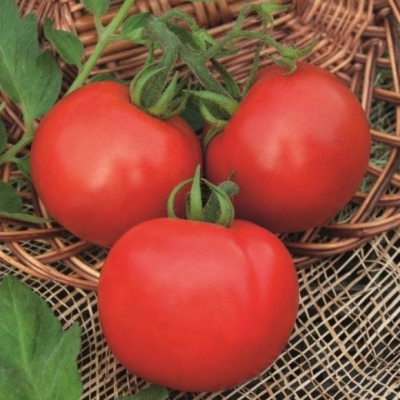
- Authors: Ognev V.V., Maksimov S.V., Klimenko N.N., Kostenko A.N., Agrofirma Poisk LLC
- Year of approval: 2013
- Category: hybrid
- Growth type: determinant
- Appointment: fresh consumption
- Ripening period: early
- Ripening time, days: 70-85
- Growing conditions: for open ground
- Transportability: good
- Marketable fruit yield,%: up to 94
Growing an early variety of tomatoes on a personal plot is the dream of every gardener. Among the many varieties declared as early ones, not everyone pleases with abundant harvests, incredible taste and unpretentious agricultural technology. One of the really early ripening and tasty varieties is the Capitan hybrid variety.
Breeding history
The hybrid seed crop Kapitan is a successful development of a group of Russian breeders (Kostenko, Klimenko, Maksimov and Ognev). The task of the scientists was to create a tomato that grows well in the middle lane, where temperatures are unstable and late summer. An early type of tomato was bred in 2010, and approved for use and entered into the State Register of the Russian Federation in 2013.
Description of the variety
The Kapitan nightshade crop is a low-growing determinant bush, stretching up to 60-70 cm. In the greenhouse, the bushes grow up to 100 cm. The plant is compact, with moderate thickening of green foliage, a strong stem and a simple type of inflorescence. Blossoming on bushes is formed by tassels. According to experts, the bushes do not require shaping and pinching, and a garter is often necessary.
The main qualities of the fruit
Tomatoes have a rounded shape with a slight ribbing on the surface. The weight of the fruit can be different - from 92 to 229 grams. When fully ripe, the tomatoes acquire a rich red color. When unripe, the berries are light green with a small depression at the stalk. The peel of tomatoes is shiny and dense, well protecting against cracking. Ripe fruits are characterized by good transportability and long shelf life. When unripe, harvested tomatoes can reach full ripeness at room temperature.
Taste characteristics
The ultra-early tomato variety has a great flavor characteristic of ground tomatoes. The tomato has dense flesh, bright sweetness in taste, perfectly combined with light sourness, and pronounced sugar content. The pulp lacks a white core, and there are practically no seeds. The aroma of the fruits is classic. It is characteristic that even the coldest and wettest summer does not affect the taste of the berries.
Tomatoes belong to the salad class, but canned and processed are just as good. The housewives are captivated by the fact that tomatoes are ideal for whole-fruit canning.
Ripening and fruiting
Tomatoes Captain are a precocious species of nightshade. From the first shoots to the appearance of ripe berries, 70-85 days pass. Fruit ripening occurs simultaneously. You can taste tomatoes from mid-July, if they grow in the garden, and at the beginning of the month, if in greenhouse conditions. The active fruiting phase begins in the first decade of July and lasts until the end of August.
Yield
The variety gives high yields. Observing all the rules of agricultural technology, from 1 hectare you can collect up to 253-402 centners of fruits per season. On 1 m2 of a garden bed, up to 17 kg of juicy tomatoes ripen.Yields in the open field and in the greenhouse may vary.
The timing of planting seedlings and planting in the ground
Sowing of seeds is carried out from 10 to 20 March. Seed germination can be accelerated by providing a greenhouse effect using glass or polyethylene. After the sprouts appear (4-5th day), the bushes need a lot of light. With the appearance of 2 true leaves, a dive is carried out (planting of bushes in separate containers). Growing seedlings will take 50-60 days. 2 weeks before planting in the ground, it is recommended to harden the seedlings daily, exposing them to fresh air.
The bushes are planted in the ground on May 10-20, when the ground and air are warm enough, and the night frosts are behind.

Growing tomato seedlings is an extremely important process, because it largely depends on whether the gardener can harvest at all. All aspects must be taken into account, from seedbed preparation to planting in the ground.
Landing scheme
The plants are compact, so up to 6-8 bushes can be planted per 1 m2 (provided they are tied to the supports). If not tied, it is recommended to place up to 4-5 kut. The optimal scheme for growing is 70x40 cm.

Growing and care
It is better to grow a crop on sandy loam soils. The best will be a semi-shaded area, cleared of weeds. The best precursors for growing tomatoes are cucumbers and cauliflower.
Plant care consists of regular watering with settled water, top dressing, loosening the soil, tying bushes and measures to protect against pests and viruses.




A plant needs different micronutrients at each stage of growth. All fertilizers can be divided into two groups: mineral and organic. Folk remedies are often used: iodine, yeast, bird droppings, eggshells.
It is important to observe the rate and period of feeding. This also applies to folk remedies and organic fertilizers.
Disease and pest resistance
The plant is invulnerable to many diseases - tobacco mosaic virus, late blight, fusarium wilting, bacteriosis.


Resistant to adverse weather conditions
This variety is not at all afraid of sudden temperature fluctuations, drought, prolonged rains and drafts. The only thing that negatively affects the development of the variety is heat (+30 and above).
Growing regions
The recommended growing regions are the North Caucasian and Central Black Earth regions.
Review overview
Both gardeners and farmers love to grow Kapitan tomatoes, as the variety is characterized by ease of care, stable and high yields, excellent taste and versatility.

























































































